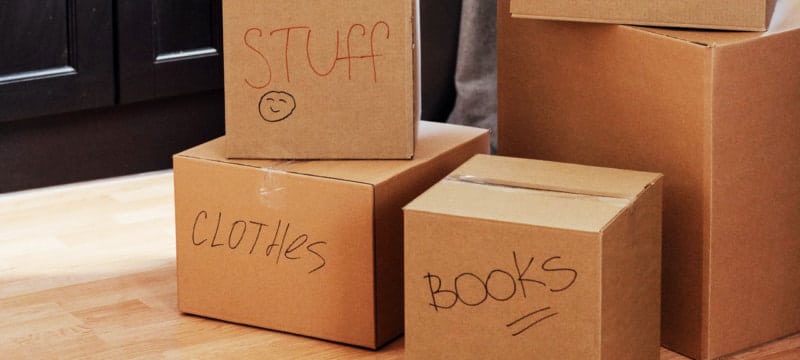Moving is a complex series of actions and decisions. Whether it’s your first or fifth move, planning is essential. This guide will help you identify frequent moving issues and find simple solutions. Let’s avoid all of the moving problems together!

Common Moving Problems and Solutions
📅 1. Poor Planning
Solution: Start with a timeline that spans 8 weeks before your move. Week-by-week tasks can include sorting belongings (Week 8), acquiring packing supplies (Week 6), and confirming mover details (Week 4). Check our moving checklist for a detailed timeline.
🔒 2. Safety Concerns
Solution: When packing and moving heavy items, use sliders under furniture legs to easily slide pieces without lifting. Employ lifting straps for bulky objects to distribute weight evenly and prevent back strain. Wear closed-toe shoes and gloves for additional protection.
🔎 3. Missing or Damaged Items
Solution: Utilize a digital app where you can catalog items by room and include photos. For example you can use Notion or just simple notes on your phone. This not only helps in keeping track but also in assessing condition pre- and post-move. Wrap fragile items in bubble wrap and secure them in boxes labeled «Fragile».
📦 4. Insufficient Supplies
Solution: For a two-bedroom home, you’ll likely need around 60 boxes, 2 rolls of bubble wrap, and 3 rolls of packing tape. Adjust quantities based on your specific needs. Local moving companies often sell supplies at competitive rates.
⚖️ 5. Overpacking
Solution: Implement the one-year rule: If you haven’t used it in a year, let it go. Read our article on decluttering to simplify the moving process. Use vacuum seal bags for clothes to save space. Keep the weight of each box under 50 pounds to ensure safety and ease of transport.
🎒 6. Essentials Accessibility
Solution: Pack a clear plastic bin with first-night essentials like toiletries, a change of clothes, medications, phone chargers, and snacks. This bin should be the last loaded and first unloaded.
💬 7. Choosing the Right Movers
Solution: Request quotes from at least three reputable companies. Check their USDOT number for legitimacy and read online reviews. Clarify if they offer additional services like packing and unpacking.
Financial Planning for Your Move
💸 Budgeting for Unexpected Costs
- Storage: If there’s a gap between moving out and moving in, storage fees might apply. Research local storage options to find the best rates.
- Utilities and Deposits: New utilities often require deposits or setup fees. Contact service providers for estimates to include in your budget.
- Last-Minute Expenses: Allocate a contingency fund for unforeseen costs. A general rule is to add 10-15% to your total estimated moving budget.
🔄 Saving on Moving Costs
- Timing: Moving during off-peak seasons (late fall to early spring) can significantly reduce mover fees. Our guide on «The Cheapest Day to Move» offers tips on scheduling to save money.
- Negotiation: Don’t accept the first quote. Compare multiple movers and negotiate services and rates. Mention competing offers as leverage.
- DIY Packing: Save by packing yourself. Use our packing guide for efficient methods.
- Deductions: Keep receipts for moving-related expenses. Some costs may be tax-deductible, especially if moving for work.
🚚 Evaluating Mover Costs and Services
- Understanding the costs involved with hiring movers is crucial for budgeting your move effectively. Reference our detailed articles on the cost of movers in Boston and costs of movers in Seattle for a comprehensive breakdown of what to expect in these cities.
Choosing the Right Moving Company
🔍 Key Considerations When Selecting Movers
- Licenses and Insurance: Ensure the company holds proper licenses and offers insurance for your belongings during the move.
- Reviews and References: Check online reviews and ask for references to gauge their reliability and customer service quality.
- Services Offered: Some movers provide full-service options, including packing, unpacking, and furniture assembly. Decide what services you need and compare offerings.
- Price Quotes: Obtain detailed quotes from at least three companies. Be wary of quotes significantly lower than the market rate, as this could indicate hidden fees or less reliable service.
💡 Tips for Negotiating with Movers
- Armed with information about average costs, negotiate to get the best deal. Mention competitor quotes, and don’t hesitate to ask for discounts or bundled services.
Packing Tips and Strategies
For a deep dive into efficient packing techniques, including a room-by-room approach and handling fragile items, refer to our comprehensive packing guide. This guide covers everything from the initial sorting of items to securely packing your most valuable possessions.
Key Highlights:
- Room-by-Room Packing: Organize your packing process by focusing on one room at a time, which simplifies tracking and unpacking.
- Fragile Items: Special materials and methods are recommended for items that require extra care.

Conclusion
As you embark on your moving, remember that preparation and knowledge are your best tools. By leveraging our comprehensive guides, from planning and budgeting to packing and choosing the right movers, you’re setting the stage for a smooth and efficient move. That way you avoid all the moving problems. Our resources, including in-depth articles on moving costs and packing strategies, are designed to support you every step of the way. Let’s make your move a success story! Contact AOA Moving Services to take the next step.
